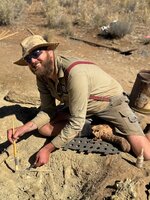~ecology-news-biolog | Bookmarks (424)
-
New research refutes notion that prehistoric kangaroos ran out of food due to specialized diets
Prehistoric kangaroos in southern Australia had a more general diet than previously assumed, giving rise to...
-
Logging and conversion of tropical forests to oil palm plantations have wide effects on ecosystems, study shows
A research team led by the University of Oxford has carried out the most comprehensive assessment...
-
Boreal forests face increased wildfire threat as tree densities shift
The extensive northern forests of Canada, Alaska and Siberia are about to fundamentally change their tree...
-
Database paves the way for first study to compare wild animal hunting patterns in African tropical forests
Advances in data availability and accessibility have resulted in a new study on wild animal hunting...
-
Nearly 30,000 wild species identified in US trade data
International research involving the University of Adelaide has found almost 30,000 wild species have been traded...
-
Dense human populations linked to longer urban coyote lifespans
Tracking coyote movement in metropolitan areas shows the animals spend lots of time in natural settings,...
-
Why do birds make so many different sounds? A study gets at the underlying factors
Birds make sounds to communicate, whether to find a potential mate, ward off predators, or just...
-
Killing the competition: Bacteria produce molecules that help viruses infect their rivals
In a new study, researchers at Indiana University Bloomington have discovered a new way that bacteria...
-
A quarter of freshwater species face extinction: Study
A quarter of freshwater animals, including fish, insects and crustaceans, are at high risk of extinction...
-
Just 7% of male humpback whales in New Caledonia may have fathered offspring
A small international team of marine mammal scientists has found evidence that just 7% of the...
-
Scientists discover a unique microbiome on our planet's roof
The streams draining the glaciers on our planet's mountaintops harbor a wealth of unique microorganisms, yet...
-
Ants hold grudges, study suggests
A team of evolutionary biologists has demonstrated that ants learn from experience. Led by Dr. Volker...
-
Young salmon may face hungry new competition from juvenile sablefish along northwest coast
There is a new mouth to feed in the coastal waters of the Northwest where juvenile...
-
Why are lemurs nearly extinct, and yet so diverse?
Lemurs, small, big-eyed primates that live in the trees of Madagascar off the southeast coast of...
-
19 times a day: Male medaka mating limits revealed
Working out the kinks of mating in the animal kingdom helps to gain insights into the...
-
Snail darter revisited: Famous fish that halted a dam's construction is not endangered after all
A team of ecologists, evolutionary biologists and resource managers affiliated with several institutions across the U.S....
-
Parasite 'matchmakers' can genetically alter plant cells to attract insects
Scientists have revealed a parasite's role in boosting male insect appeal by modulating host processes to...
-
Artists discover a new glowing mushroom in Switzerland
Glowing mushrooms are often associated with tropical environments, but they can also be found in Switzerland....
-
Spiders 'smell' with their legs, new research finds
Spiders have always lived alongside humans, so it's surprising how much we still don't know about...
-
Models predict climate change will lead to increase in invasive spongy moth outbreaks
Computer models developed by the University of Chicago and Argonne National Laboratory predict that hotter, drier...
-
Rare video captures following and biting courtship behavior in elusive whale sharks
Courtship and procreative behavior in many species of elasmobranchs—cartilaginous fish including rays, sawfish, sharks, and skates—may...
-
'Toxic Male Technique' promises faster biocontrol of mosquito populations
A new biological pest control method that targets the lifespan of female insects could significantly reduce...
-
A fast-moving belly flop: Researchers unveil the unique skills of cricket frogs
Is walking on water possible for frogs? Several species have fascinated observers with their abilities to...
-
Microplastics are widespread in seafood that people eat, study suggests
The tiny particles that are shed from clothing, packaging and other plastic products are winding up...



























